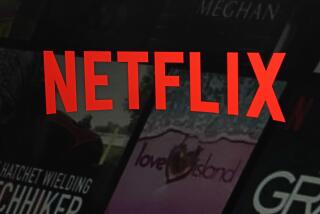Once high-flying Netflix is now stumbling
Netflix Inc., just a few months ago considered the unstoppable titan of the entertainment industry, is suddenly looking more like the Titanic.
The company that transformed DVD rentals with its subscription mail service, added easy-to-use Internet video streaming and amassed 25 million subscribers throughout the Western hemisphere has found itself pummeled over the last two months by furious and departing customers, balky suppliers in Hollywood and a diving stock price.
Netflix, now 12 years old, seems to have lost an important part of what originally made it a sensation: its ability to anticipate the changing preferences of home entertainment consumers and figure out how much they were willing to pay. Making matters worse, Hollywood studios have gradually been putting the squeeze on the number of movies they make available to Netflix for streaming.
“Up until July this was a company that could do nothing wrong,” said Justin Patterson, a Morgan Keegan equity research analyst. “In the past two months it miscalculated the response to its new pricing plans and now it risks miscalculating again by degrading the usability of its service.”
Even an apology this week from its co-founder wasn’t enough to appease the growing chorus of critics. The upshot, at least for many of the most vocal subscribers, is that Netflix is charging more and offering less.
After four years of nonstop growth, Netflix’s troubles began over the summer when it surprised its customers with a new pricing structure that added as much as 60% to the monthly bill of people who watch both DVDs and online video. Then came news that Netflix’s streaming service would lose access to new movies from Walt Disney Studios and Sony Pictures in February. About 400,000 subscribers have deserted, and the company stock price has fallen 52% since July 13.
Late Sunday, Netflix hastily announced a reorganization that came with a partial mea culpa from Reed Hastings, its co-founder and chief executive. In an email to subscribers, a blog post and a YouTube video that featured him dressed casually outside of the company’s Los Gatos, Calif., headquarters, Hastings apologized — but not for the policy changes, only for the way they were communicated.
“In hindsight, I slid into arrogance based upon past success,” he said. “I should have personally given a full justification to our members of why we are separating DVD and streaming, and charging for both. It wouldn’t have changed the price increase, but it would have been the right thing to do.”
The move immediately backfired.
Hastings’ blog post resulted in more than 17,000 comments, the vast majority negative. “Not buying this,” wrote user Andrew Terranova of Philadelphia. “The fact is, Netflix offered a fantastic service for years. Then they started to remove features and up the price. It’s greed, plain and simple.”
Hastings also said Netflix’s DVD business would be separated into a new unit with its own brand name, Qwikster. The 12 million people — half the subscribers — who have signed up for both DVDs and streaming now must visit two websites to search for and order movies.
Qwikster will also add the option to rent video games, a strategy that Netflix has long denied it was interested in pursuing.
Analysts and experts, meanwhile, were largely baffled by the latest move.
Sasha Strauss, a brand strategy consultant and adjunct lecturer at the USC Annenberg School for Communication & Journalism, said launching the Qwikster brand in the next few weeks would be a risky move.
“Netflix is such a powerful brand that it’s a category descriptor, like Kleenex or Google,” he noted. “Now it’s making people form a new relationship with a new brand and trying to justify it purely in business terms.”
Several analysts suggested that separating the Qwikster brand could be a precursor to selling or spinning it off, a claim that Netflix spokesman Steve Swasey denied.
Netflix built its business on the simplicity of ordering from a virtually unlimited library of movies on DVD by mail, eliminating the need to go to the video store and letting customers keep the videos as long as they wanted.
Today, though, Hastings sees the future of Netflix in video streaming, without the associated costs of packaging and shipping DVDs. He and other executives have said the increased costs of acquiring digital movies and television shows have forced the price increases, in which customers pay separately for DVDs and streaming.
For example, this month the pay cable channel Starz, which controls rights to popular titles like “Tangled” and “The Karate Kid” from Disney and Sony, said it wouldn’t renew a deal to let Netflix stream those films when it expires in February. Paramount Pictures, maker of the “Transformers” movies, will then be the only major studio whose recent releases will be available online to Netflix subscribers.
Most of Netflix’s video streams already are television reruns, a trend likely to continue. Customers seem particularly drawn to serialized dramas, like “Lost” and “24.” Netflix recently agreed to pay nearly $1 million an episode for rerun rights to “Mad Men.” The company also is developing its own original drama series.
Netflix’s troubles are opening opportunities for competitors. They include Amazon.com, which already has a small but growing streaming service, and Blockbuster, now owned by Dish Network, which is expected to unveil a similar offering Friday. That’s an irony given that only a few years ago Blockbuster was the lumbering giant in home video that was topped by a more nimble upstart called Netflix.
Now analysts say Netflix is vulnerable.
“The competition isn’t really on the field yet, but it’s in the locker room getting laced up,” said analyst Daniel Ernst of Hudson Square Research. “That will give disgruntled Netflix subscribers a place to go.”
Times staff writer Emily Rome contributed to this report.
More to Read
The biggest entertainment stories
Get our big stories about Hollywood, film, television, music, arts, culture and more right in your inbox as soon as they publish.
You may occasionally receive promotional content from the Los Angeles Times.










